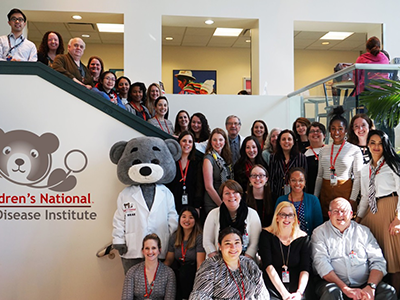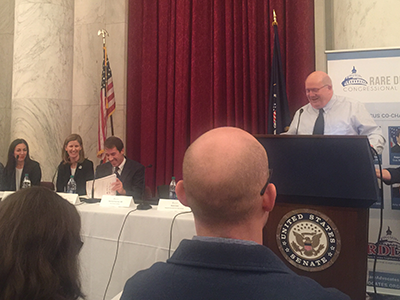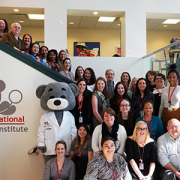Genetics 101: Rare diseases aren’t rare

Children’s National Health System is home to the Rare Disease Institute, the National Organization for Rare Disease’s first Center of Excellence, the largest clinical genetics program in the United States.
With the advent of DNA databanks, informatics, new technology, pediatric consortiums and global partnerships, clinical researchers have never been in a better position to diagnose and treat rare diseases. A rare disease is categorically defined as a condition that affects less than 200,000 people. However, 25 to 30 million Americans, about one in 10, have a rare disease.
Accelerations in genetic research and diagnostic criteria remain one of the most significant accomplishments in medicine, but these breakthroughs invite new challenges: How will researchers provide ongoing care and treatment for patients navigating a rare disease? How can doctors and researchers multiply themselves to ensure everyone has the latest information and resources they need? How can researchers use existing trials to augment other fields? How can we diagnose, catalogue and treat hundreds of new rare diseases each year, while accelerating the research and care of 7,000 existing rare conditions?
If these questions intrigue you, excite you and make you want to collaborate with scientific peers, welcome to the field of genetics. A common theme researchers and families talk about is that rare diseases affect a small proportion of the population, but have a huge impact.
On April 10, 1,200 international researchers, lawmakers, scientists and drug developers from 50 countries will meet in Oxon Hill, Md., 10 miles south of Washington, for a three-day summit, the World Orphan Drug Congress USA, to discuss how to unify efforts to enhance and maximize care for rare disease patients.
Here are eight themes to keep in mind:
-
- Rare diseases are chronic diseases. The human genome project has enabled the molecular mapping of 8,000 diseases with genetic underpinnings. Of these diseases, 600 diseases have therapies. A child born with a urea cycle disorder had a 5% chance of surviving the disease 40 years ago. Now the survival rate is 95%. Helping children survive is essential, but we need to think about the best treatments and standards for long-term care.
- Rare diseases are expensive. In Western Australia, according to the 2010 Western Australia Population Cohort, rare diseases account for less than 5% of hospital visits but for 10% of hospital costs. Similar data from Cleveland finds one-third of pediatric hospital visits have a genetic link but account for half of hospital costs.
- Rare diseases share common links. We’ve diagnosed 7,000 rare diseases but there are more to unravel. For example, breast cancer has over 30 molecular subtypes – some of which turn into rare diseases. By better understanding these molecular pathways, we may be able to inform common fields of medicine.

Dr. Marshall Summar, a medical geneticist, speaks about the future of rare disease research and treatment at a Rare Disease 101 lecture hosted by the Rare Disease Congressional Caucus on Capitol Hill on Feb. 27. To sustain discoveries, Dr. Summar mentions a digital-first, flexible mindset is essential. Standard language and scalable, universal reference structures are required.
- Global partnerships create research repositories. Gold-standard research models – double blind, controlled studies with numerous participants – aren’t possible if five people in the world share the same disease. To increase the number of study participants, global partnerships and longitudinal registries are essential.
- Standard language helps. To avoid replicating existing research and to help teams quickly reference findings, we need to adopt standardized language to quantify measurements. Researchers from Berlin and Brazil may help inform the etiology of and future treatments for PKU, but they need to manage, store, access and share their collective findings, while remaining flexible.
- The science is here. The FDA is approving more drugs for rare diseases than ever before including gene therapy and micro organs, or Rare Diseases-on-chip models. The challenge with treating so many rare diseases isn’t developing new research, but creating therapies and studies to accommodate this patient volume. About 250 rare disease discoveries happen each year. At the current rate, it will take 2,000 years to treat them all.
- Progress is here. The Orphan Drug Act fast-tracked approval for rare disease treatments and therapies, and nearly half of all drugs coming in for FDA approval are for rare diseases. However, only 5% of rare diseases have FDA-approved drugs.
- We need to replicate geneticists. To provide optimal care, doctors need to standardize education models and use new forms of technology, such as artificial intelligence and deep learning, to share resources faster via patient education portals, resources for families, CME courses and virtual connections with pediatricians or families.
If you live in Washington, D.C., follow the genetics team and consider working with us as we move into a new home, the Children’s National Research and Innovation Campus, in 2020.



